Math Class: 4 Must-Do’s to Start the New Year
A MiddleWeb Blog
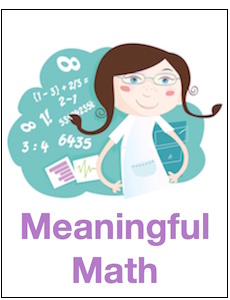 The first few days of school are always exciting and stressful. This year was no exception. Typically, I enjoy the rush of the new year. You get to meet your students and introduce them to your classroom. I feel like it’s important to be a good host, especially during the first week when my students might be having jitters too.
The first few days of school are always exciting and stressful. This year was no exception. Typically, I enjoy the rush of the new year. You get to meet your students and introduce them to your classroom. I feel like it’s important to be a good host, especially during the first week when my students might be having jitters too.
The problem this year was a lack of time. We had many duties needing completion before school started. We had to create new pacing guides, update benchmarks, and attend many meetings.
This probably sounds familiar to most teachers. I began to feel panicked and stressed out. I was putting a huge amount of pressure on myself to make the beginning of school perfect or at least to “top” what I had done last year.
At some point, I decided that I had to stop stressing and be reasonable about what I could accomplish. I know that welcoming my new students to my classroom is really important. Yet, I’m also convinced that the first weeks of school can set the tone for the year.
So I thought carefully about what I wanted to accomplish right away – and how I could do it while maintaining my sanity. I eventually came up with four main areas I wanted to address before school became routine, and I concentrated on those and let everything else go.
1. Getting to Know My Students and Building Relationships
Of course building relationships with students is always important. So to work on this I had my students fill out a short questionnaire related to their favorite things – hobbies, entertainment, feelings about math, etc. I made the survey after reading several online, and it’s nothing fancy.
I pared my survey down from last year so it would fit on one page, making it easier to read all of the responses the first night of school. The next day I used it to help me start conversations with my students. I found some really interesting things about these kids!
Something new I did this year was to print the student questionnaire on one side and a blank copy of a parent communication log on the other side. I put them all in a binder so I will have their questionnaire responses as a reference when I call or send messages to parents and caregivers.
I’ve learned over the years that getting students’ names right and mastering them quickly can help foster relationships. I have to work really hard to remember names and to pronounce everyone’s name correctly. Usually I call roll at the beginning of class and invariably butcher some poor student’s name.
This year while students were filling out their questionnaire, I walked around the room and spoke briefly to each student and had them pronounce their name(s) for me. I wrote the phonetic spellings on my class roster so I could practice that night.
This worked so much better than me calling roll and mispronouncing students’ names in front of the whole class. It saved me that embarrassment and showed the students that getting their name right is important to me. It also was better for shy students who may not be comfortable correcting a teacher’s pronunciation of their name in front of the whole class. Plus I got to spend a moment talking to each student on day one.
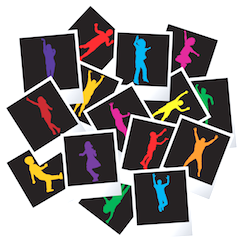
Random Groupings
Randomly grouping students with other students to complete various math tasks has become a big part of my classroom in the last few years.
Last year I realized that I needed many, many ways to randomly group students. Also I wanted my students to know from the very beginning that our classroom is a community and we will all be working together. There are many “tech” options which randomly group students and they are great, but I also like non-tech tools.
One that I’d been meaning to try is “clock buddies.” Every student gets a blank template of a clock, walk around the room, and find a different buddy for each hour on the clock. In even numbered classes you end up with groups of four; in odd numbered classes you will have one group of 3. When you want to randomly group students, you just tell them to find their six o’clock buddy, for example.
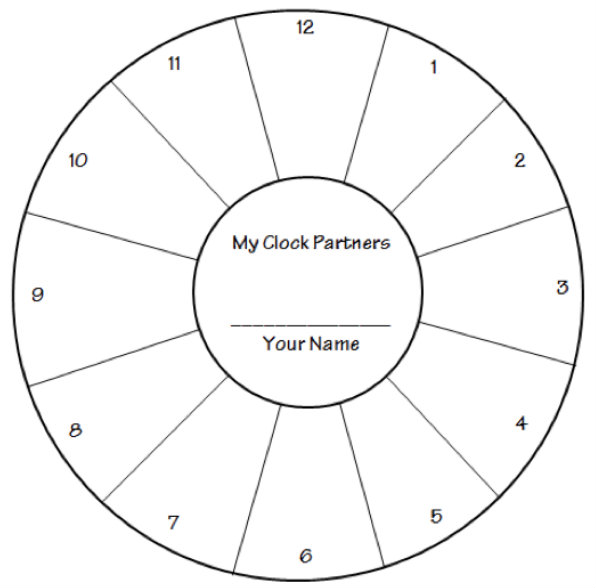
I realized that it helps if you put the students in two rows facing each other and then rotate as they fill in their clock. Also, I recommend making copies of all of the students’ clocks in case they lose theirs. One advantage that I didn’t foresee was that – in the process of finding buddies – they were talking to each other and introducing themselves to students they didn’t know.
Classroom Management
I wish classroom management was something I was so good at I didn’t have to think about it – but that’s not the case for me. So we did spend some time discussing my procedures and expectations, and I had the students fill in a “Doodle Syllabus” which I completely reworked to align with my Classroom Procedures. (I emailed the author and she sent me an editable version!)
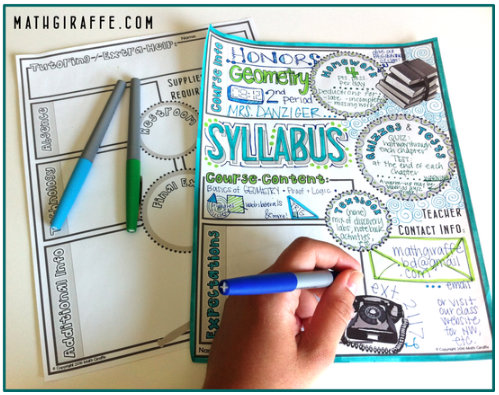
Get Students Excited About Math
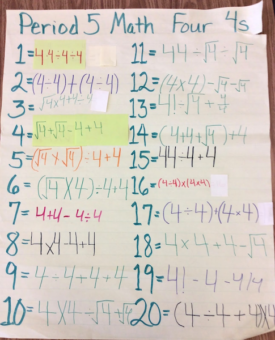
Although I didn’t do as much this year as I did last year and it definitely wasn’t flashy, I feel good about how I started the school year with my students. I was able to address the four areas I was really concerned about and spent more time talking to my students one on one. I really enjoyed meeting all of them, and “downsizing” allowed me to keep my sanity!
Source: Four 4’s example




































I love the Four 4’s and have used it at Open House and got the parents involved. It was great fun and many of them sent the student back days later with more ideas – this went on for weeks.
What a fun activity! I’ll have to try this out!